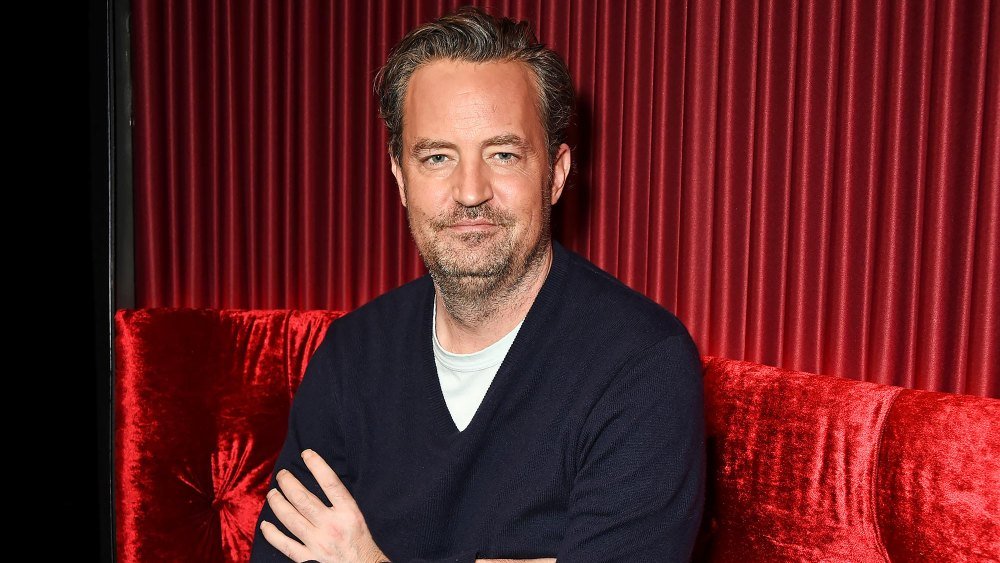Entertainment
Matthew Perry Was ‘Deceased’ Prior to Emergency Responders’ Arrival on October 31, 2023 at 3:51 am Us Weekly

David M. Benett/Dave Benett/Getty Images
Matthew Perry was found “unconscious in a stand-alone jacuzzi” when first responders arrived to his home on Saturday, October 28.
“A bystander had brought the man’s head above the water and gotten him to the edge, then Firefighters removed him from the water upon their arrival,” a spokesperson for the Los Angeles Fire Department told CNN in a Monday, October 30, statement. “A rapid medical assessment, sadly, revealed the man was deceased prior to first responder arrival.”
Earlier on Monday, Los Angeles Fire Department spokesperson Nicholas Prange told Page Six that firefighters “didn’t perform CPR” on Perry after arriving at his Pacific Palisades residence “because he was already beyond medical help.”
Authorities reportedly discovered Perry after they responded to a call of someone going into cardiac arrest on Saturday. There were reportedly no signs of foul play at the scene, but according to the Los Angeles County Medical Examiner, his cause of death has been “deferred” following his initial autopsy as the results were determined to be inconclusive pending a toxicology report. Further investigation into the cause of Perry’s death has been requested. He was 54.
Perry was best known for his portrayal of Chandler Bing on Friends, which ran for 10 seasons from 1994 to 2004. Earlier on Monday, the actor’s former costars mourned the loss of their longtime pal.
“We are all so utterly devastated by the loss of Matthew. We were more than just cast mates. We are a family,” Jennifer Aniston, Courteney Cox, Lisa Kudrow, Matt LeBlanc and David Schwimmer told Us Weekly in a joint statement on Monday, October 30. “There is so much to say, but right now we’re going to take a moment to grieve and process this unfathomable loss.”
“In time we will say more, as and when we are able,” the statement continued. “For now, our thoughts and our love are with Matty’s family, his friends, and everyone who loved him around the world.”
While filming the NBC sitcom, Perry developed an addiction to Vicodin after a Jet Ski accident in 1997. That eventually led to alcohol abuse, which affected his performance on set. In 2000, he was hospitalized with pancreatitis. Perry made multiple attempts to get sober during his time on Friends, eventually entering recovery prior to their 2021 Max reunion, where Perry opened up about being hard on himself while filming scenes as his character, Chandler.
“I felt like I was gonna die if they didn’t laugh. It’s not healthy for sure, but I would sometimes say a line and they wouldn’t laugh, and I would sweat and go into convulsions,” he told his former costars. “If I didn’t get the laugh I was supposed to get, I would freak out. I felt like that every single night.”
Although Perry knew that he would ultimately be remembered for his time on Friends, he previously opened up about also wanting his legacy to center around the “help” he offered others.
“The best thing about me, bar none, is that if somebody comes to me and says, ‘I can’t stop drinking, can you help me?’ I can say ‘yes’ and follow up and do it,” Perry said on the “Q With Tom Power” podcast in 2022. “When I die, I don’t want Friends to be the first thing that’s mentioned. I want that to be the first thing that’s mentioned. And I’m gonna live the rest of my life proving that.”
In 2013, Perry converted his Malibu home into a sober living facility for men called Perry House, which offered holistic services to help men get sober.
David M. Benett/Dave Benett/Getty Images Matthew Perry was found “unconscious in a stand-alone jacuzzi” when first responders arrived to his home on Saturday, October 28. “A bystander had brought the man’s head above the water and gotten him to the edge, then Firefighters removed him from the water upon their arrival,” a spokesperson for the
Us Weekly Read More
Entertainment
What We Can Learn Inside 50 Cent’s Explosive Diddy Documentary: 5 Reasons You Should Watch

50 Cent’s new Netflix docuseries about Sean “Diddy” Combs is more than a headline-grabbing exposé; it is a meticulous breakdown of how power, celebrity, and silence can collide in the entertainment industry.
Across its episodes, the series traces Diddy’s rise, the allegations that followed him for years, and the shocking footage and testimonies now forcing a wider cultural reckoning.

1. It Chronicles Diddy’s Rise and Fall – And How Power Warps Reality
The docuseries follows Combs from hitmaker and business icon to a figure facing serious criminal conviction and public disgrace, mapping out decades of influence, branding, and behind-the-scenes behavior. Watching that arc shows how money, fame, and industry relationships can shield someone from scrutiny and delay accountability, even as disturbing accusations accumulate.

2. Never-Before-Seen Footage Shows How Narratives Are Managed
Exclusive footage of Diddy in private settings and in the tense days around his legal troubles reveals how carefully celebrity narratives are shaped, even in crisis.
Viewers can learn to question polished statements and recognize that what looks spontaneous in public is often the result of strategy, damage control, and legal calculation.
3. Survivors’ Stories Highlight Patterns of Abuse and Silence
Interviews with alleged victims, former staff, and industry insiders describe patterns of control, fear, and emotional or physical harm that were long whispered about but rarely aired in this detail. Their stories underline how difficult it is to speak out against a powerful figure, teaching viewers why many survivors delay disclosure and why consistent patterns across multiple accounts matter.
4. 50 Cent’s Approach Shows Storytelling as a Tool for Accountability
As executive producer, 50 Cent uses his reputation and platform to push a project that leans into uncomfortable truths rather than protecting industry relationships. The series demonstrates how documentary storytelling can challenge established power structures, elevate marginalized voices, and pressure institutions to respond when traditional systems have failed.
5. The Cultural Backlash Reveals How Society Handles Celebrity Accountability
Reactions to the doc—ranging from people calling it necessary and brave to others dismissing it as a vendetta or smear campaign—expose how emotionally invested audiences can be in defending or condemning a famous figure. Watching that debate unfold helps viewers see how fandom, nostalgia, and bias influence who is believed, and why conversations about “cancel culture” often mask deeper questions about justice and who is considered too powerful to fall.
Entertainment
South Park’s Christmas Episode Delivers the Antichrist

A new Christmas-themed episode of South Park is scheduled to air with a central plot in which Satan is depicted as preparing for the birth of an Antichrist figure. The premise extends a season-long narrative arc that has involved Satan, Donald Trump, and apocalyptic rhetoric, positioning this holiday episode as a culmination of those storylines rather than a stand‑alone concept.
Episode premise and season context
According to published synopses and entertainment coverage, the episode frames the Antichrist as part of a fictional storyline that blends religious symbolism with commentary on politics, media, and cultural fear. This follows earlier Season 28 episodes that introduced ideas about Trump fathering an Antichrist child and tech billionaire Peter Thiel obsessing over prophecy and end‑times narratives. The Christmas setting is presented as a contrast to the darker themes, reflecting the series’ pattern of pairing holiday imagery with controversial subject matter.
Public and political reactions
Coverage notes that some figures connected to Donald Trump’s political orbit have criticized the season’s portrayal of Trump and his allies, describing the show as relying on shock tactics rather than substantive critique. Commentators highlight that these objections are directed more at the depiction of real political figures and the show’s tone than at the specific theology of the Antichrist storyline.
At the time of reporting, there have not been widely reported, detailed statements from major religious leaders focused solely on this Christmas episode, though religion-focused criticism of South Park in general has a long history.
Media and cultural commentary
Entertainment outlets such as The Hollywood Reporter, Entertainment Weekly, Forbes, Slate, and USA Today describe the Antichrist arc as part of South Park’s ongoing use of Trump-era and tech-world politics as material for satire.
Viewer guidance and content advisory
South Park is rated TV‑MA and is intended for adult audiences due to strong language, explicit themes, and frequent use of religious and political satire. Viewers who are sensitive to depictions of Satan, the Antichrist, or parodies involving real political figures may find this episode particularly objectionable, while others may view it as consistent with the show’s long‑running approach to controversial topics. As with previous episodes, individual responses are likely to vary widely, and the episode is best understood as part of an ongoing satirical series rather than a factual or theological statement.
Entertainment
Sydney Sweeney Finally Confronts the Plastic Surgery Rumors

Sydney Sweeney has decided she is finished watching strangers on the internet treat her face like a forensic project. After years of side‑by‑side screenshots, “then vs now” TikToks, and long comment threads wondering what work she has supposedly had done, the actor is now addressing the plastic surgery rumors directly—and using them to say something larger about how women are looked at in Hollywood and online.

Growing Up on Camera vs. “Before and After” Culture
Sweeney points out that people are often mistaking normal changes for procedures: she grew up on camera, her roles now come with big‑budget glam teams, and her body has shifted as she has trained, aged, and worked nonstop. Yet every new red‑carpet photo gets folded into a narrative that assumes surgeons, not time, are responsible. Rather than walking through a checklist of what is “real,” she emphasizes how bizarre it is that internet detectives comb through pores, noses, and jawlines as if they are owed an explanation for every contour of a woman’s face.
The Real Problem Isn’t Her Face
By speaking up, Sweeney is redirecting the conversation away from her features and toward the culture that obsesses over them.
She argues that the real issue isn’t whether an actress has had work done, but why audiences feel so entitled to dissect her body as public property in the first place.
For her, the constant speculation is less about curiosity and more about control—another way to tell women what they should look like and punish them when they do not fit. In calling out that dynamic, Sweeney isn’t just defending herself; she is forcing fans and followers to ask why tearing apart someone else’s appearance has become such a popular form of entertainment.

 Entertainment4 weeks ago
Entertainment4 weeks agoColombia’s ‘Doll’ Arrest: Police Say a 23-Year-Old Orchestrated Hits, Including Her Ex’s Murder

 Entertainment4 weeks ago
Entertainment4 weeks agoHow The Grinch Became The Richest Christmas Movie Ever

 Entertainment4 weeks ago
Entertainment4 weeks agoMiley Cyrus Is Engaged to Maxx Morando

 Business3 weeks ago
Business3 weeks agoLuana Lopes Lara: How a 29‑Year‑Old Became the Youngest Self‑Made Woman Billionaire

 Film Industry2 weeks ago
Film Industry2 weeks agoDisney Brings Beloved Characters to ChatGPT After $1 Billion OpenAI Deal

 Entertainment4 weeks ago
Entertainment4 weeks agoMariah Carey’s One Holiday Hit Pays her $3.3 Million a Year

 Film Industry3 weeks ago
Film Industry3 weeks agoNetflix Got Outbid: Paramount Drops a $108 Billion Cash Bomb on Warner Bros.

 Entertainment4 weeks ago
Entertainment4 weeks agoAnne Hathaway Just Turned Her Instagram Bio Into a 2026 Release Calendar



























